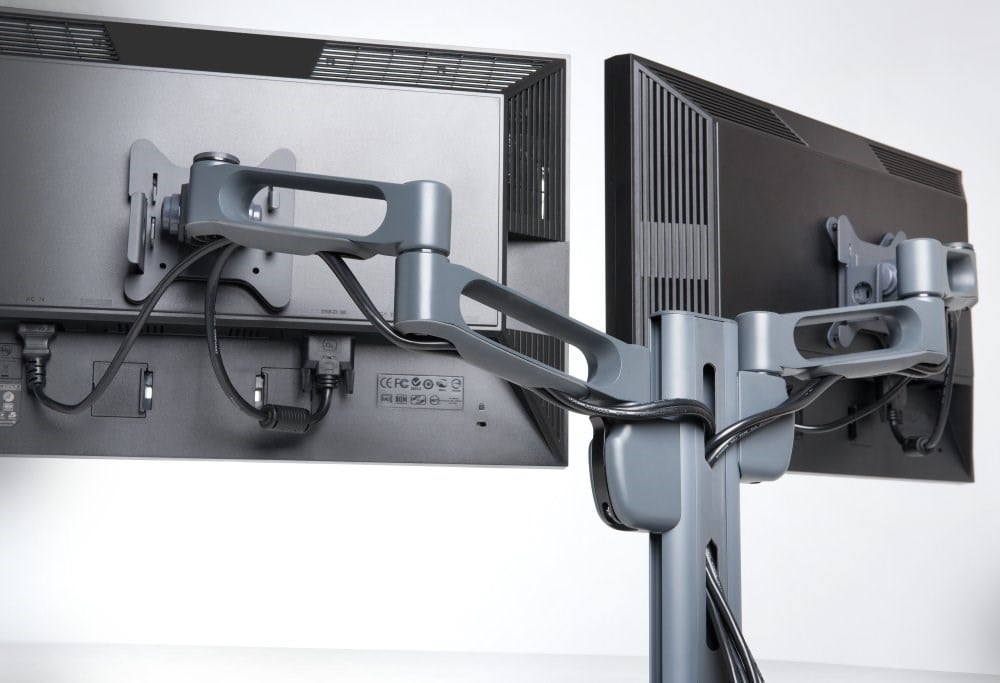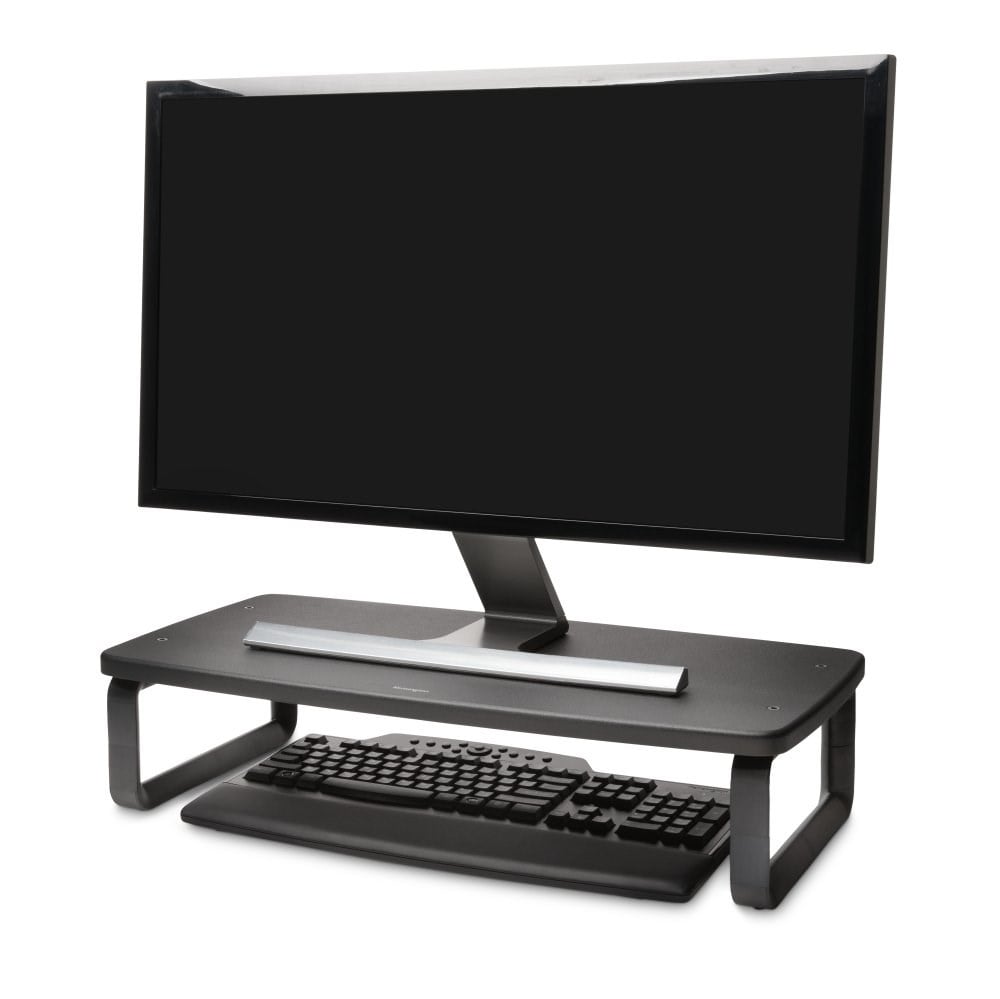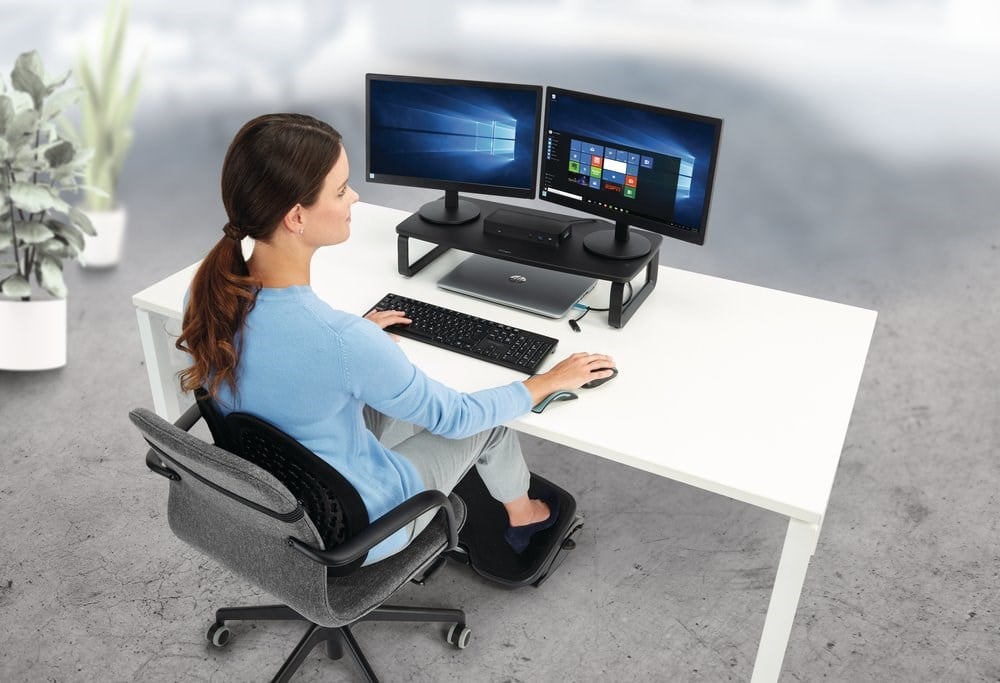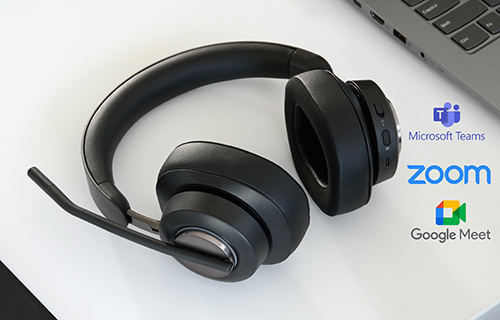
Picking out the ideal monitor arm for your needs is only the first step in finding greater comfort and productivity with the equipment. This blog post will walk you through Step 2: how to find the monitor placement that allows you to find your most comfortable working posture, and how to take special care of your eyes to completely prevent computer eye strain.
The 4 Steps to finding the Perfect Ergonomic Monitor Placement, for the Most Comfortable Posture
Once you pick out your monitor arm, you'll need to set it up just right to find that comfortable posture. Note that the recommendations in these steps are subject to adjust a bit according to your unique use case: the kind of desk you're using, your monitor style and quantity, and the kind of corrective lenses you wear, if any (all unique situations which we discuss below).
Step 1. Center the monitor, placing it directly in front of you.
Centering your monitor ensures that you aren't torquing your neck in order to view your screen. Note that it is acceptable to place the monitor slightly to the side if it's a screen you only peer at occasionally throughout the day.
Step 2. Position the monitor at roughly an arm's length away.
Your monitor should be at least 20 inches from your eyes when standing or sitting in the position that you will work from (i.e. about an arm's length). Sitting too close to the screen will hurt your eyes while sitting too far will fatigue your eyes from the strain to see your work — achieving the right distance here allows the postural alignment of your entire upper body, with awkward postural corrections abated.
Step 3. Place the monitor so that when looking at the middle of the screen, your eyes are shifted just slightly downward.
The eyes naturally fall at a downward cast, and looking upward (above the horizontal point) is tiring for them. So when you are seated or standing comfortably, your eyes should be in line with a point on the screen about 2-3 inches below the top of the monitor casing.
Step 4. Tilt the monitor backward 10-20°.
This maintains that healthy distance between your screen and your eyes that prevents any computer eye strain or fatigue. Just make sure that the tilt doesn't direct a glare or reflection of light from the office into your eyes.
Special Exceptions: Ergonomic Monitor Placement
Large Monitor (> 20 inches wide)

If your monitor is 20 inches wide or more, you should set it slightly farther away than an arm's length distance, making sure the top of the screen isn't at a level higher than the eye. Generally, the larger the screen, the more distance you'll need for comfortable work.
If you opt for a monitor stand to raise your large monitor, find a stand with an extra-wide universal platform for the desired stability.
Dual-Monitor Layout
First, determine how much you use each monitor to find the best monitor placement— do you use them equally, or one more than the other?
→ If you use each monitor equally: Place both monitors as close together as possible, centering them directly in front of you with their inner edges touching, and angling the screens to create a semi-circle.
→ If you use one monitor more than the other: Place the primary monitor directly in front of you (as you would a single monitor), and place the secondary monitor on the side at an angle (creating a semi-circle) — ideally on the side of your dominant eye, if you have one.
Multi-Monitor Layout

Center your primary monitor and place the second and third on either side, as close together as possible, with their edges touching, angling the screens to create a semi-circle. If you have a dominant eye, place the secondary screen on the side of your dominant eye and the third screen on the other side.
Corrective Lenses
Note that, for computer work, you want to view your screen comfortably through the main (distant, top) portion of your lens and be able to gaze beyond the monitor into the room as desired. Appropriately, you'll want to place the monitor(s) slightly lower than the traditionally recommended height if using corrective lenses of any kind, so you don't have to tilt your head downward to see your work through this main portion of your lens. The following process will guide you:
→ First, find your personal ergonomic monitor height. To achieve this, find your neck's comfortable resting position first by nodding your head up and down and resting it where most comfortable. Then find the comfortable resting position for your eyes by moving them up and down with your eyes closed and resting them where most comfortable. Now, open your eyes and look through the main part of your bifocal lenses OR the top portion of your vision progressive lenses — your line of sight should fall naturally on the top third of your monitor screen, through the correct portion of your lens appropriate for distance viewing. If it does not, adjust your monitor accordingly.
→ Second, find your personal ergonomic monitor tilt. Once you find the right monitor height, tilt the screen back 30-40° (a bit farther backward than the traditional 10-20°) so the monitor can be seen without bending the head, neck, or trunk forward or backward.
→ Last, find your personal ergonomic monitor distance. Because your corrective lenses are designed to provide clear sight at a particular viewing distance, you'll need to experiment a bit here to find the sweet spot of clear vision. Place the monitor at an arm's length and then have a co-worker bring the monitor(s) slightly forward and backward for you, until you find that sweet spot of your sharpest, most comfortable vision.
If You're a Bit Overwhelmed by Ergonomics...
Consider a product with an integrated system that guides you through the process of finding your own perfect, ergonomic fit. Take our SmartFit® system for example, which identifies a starting point for finding comfort. How does it work? You place your hand on a color-coded hand-size chart — the color filled by your hand identifies the recommended position to fix your monitor arm (or other product) at. Because the size of your hand correlates to the proportions of your whole body, the system acts as a scientifically-backed guide for setting up your ergonomic workstation correctly.
A few of our SmartFit System products:
- SmartFit® One-Touch Height Adjustable Single Monitor Arm for a single monitor setup
- SmartFit® One-Touch Height Adjustable Dual Monitor Arm for a dual-monitor setup
- SmartFit® Extra Wide Monitor Stand for up to 27" screens for a large or curved monitor setup
- Monitor Stand with SmartFit® System for a simple monitor stand setup
- SmartFit® Monitor Stand with Drawer for a simple monitor stand setup and extra storage
- Kensington® SmartFit® Spin2™ Monitor Stand for a simple monitor stand setup with extra storage, and a useful spinning feature
Extra Eye Care Tips:
- Follow the 20-20-20 rule. Take a 20 second break every 20 minutes and gaze off into the distance at least 20 feet away. This gives your eyes a restorative break so that visual fatigue is prevented and the eye muscles are routinely exercised for good health and best eyesight.
- Get your eyes checked and your prescription updated regularly.
- Blink often or use eye drops to keep your eyes moist. If your eyes dry out, use eye drops to keep them moist and make a conscious effort to blink regularly (we sometimes forget to blink when focusing on computer work).
- Increase the font size and adjust the font color for easier reading. The font on your screen should be at least two or three times the size of the smallest text that you can read, and black text on a white background is the easiest font/background color combination on the eyes.
- Balance the brightness of your monitor to your surroundings. The brightness of your monitor should be approximately equal to the area behind it, as contrast between the two, strains the eyes. Adjustments of monitor brightness throughout the day may be necessary as the natural light in the room changes.
- A simple test: open up a word document and observe. If the light emitted feels like a strong source of light on your eyes, the brightness of your screen is too high.
- Eliminate glare and reflection on your screen. Reducing glare and reflection on your screen eliminates the blinding effect of natural light, bright overhead office lights, and reflective walls and surface finishings. This can be done by turning the screen away from these sources of light at an angle that doesn't reflect any glare into your eyes. Closing the curtains or using a computer hood are also great solutions if the level of light in the room is simply too high.
- A simple test: Turn your monitor off and observe the screen for any noticeable reflections of light. And note that if you are squinting, your eyes are straining.
- Keep your screen clean. Dust and fingerprints make it more difficult to see what's on your screen.
- Try out blue light blocking computer glasses or adjust the color temperature of your screen. Blue light is a big culprit of computer eye strain — not only fatiguing and straining the eyes, causing headaches, but also interfering with one's natural circadian rhythm. The fatigue, discomfort, and blurred or compromised vision negatively affect comfort and productivity. A simple fix is to wear blue light blocking glasses or adjust the color temperature of your screen to an orange or red hue.
- Consider a privacy screen for your monitor. Like a film that adheres to your monitor and protects both your eyes and your work, a privacy screen reduces glare, blocks computer blue light, and prevents onlookers on either side of you from viewing your work. Our line of privacy screens use an anti-reflective coating that blocks blue light up to 30% and attaches to your monitor either magnetically, with double-sided tape, frameless tab holders, or with adjustable springs.
By following the simple 4-step process for finding the right monitor placement for comfortable posture, noting special exceptions on placement for your desk and monitor layout and/or eyeglass prescription, and adopting important habits for taking care of your eyes while at work, you'll be feeling comfortable and focused with your new equipment in no time!
